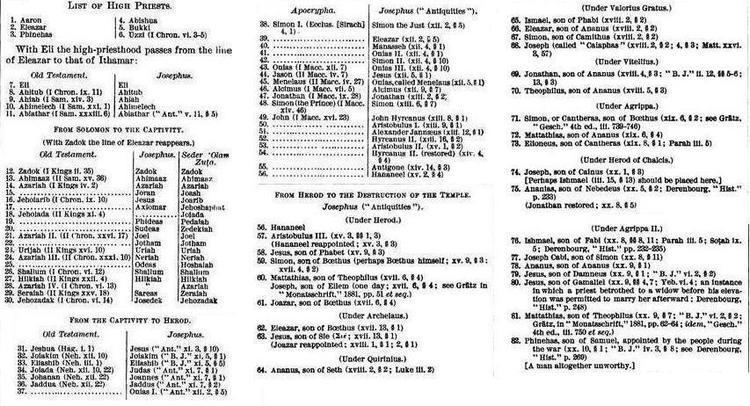 | ||
This page gives one list of the High Priests of Ancient Israel up to the destruction of the Second Temple in 70 AD. Because of a lack of historical data, this list is incomplete and there may be gaps.
Contents
Line of the High Priests of Israel
The High Priests, like all Levitical priests, belonged to the Aaronic line. The Bible mentions the majority of high priests before the captivity, but does not give a complete list of office holders. Lists would be based on various historical sources. In several periods of gentile rule, high priests were appointed and removed by kings. Still, most high priests came from the Aaronic line. One exception is Menelaus, who may not have been from the Tribe of Levi at all, but from the Tribe of Benjamin.
From the Exodus to Solomon's Temple
The following section is based on information found in the various books of the Bible, including the genealogies given in First Book of Chronicles and the Book of Ezra, the works of Josephus and the early-medieval Seder 'Olam Zutta.
Though Phinehas and his descendants are not directly attested as high priests, this portion of the genealogy given in 1 Chronicles 5:30-41 is assumed by other sources (including Josephus and Seder 'Olam Zutta), to give the succession of the office from father to son. At some time, the office was transferred from descendants of Eleazar to those of his brother Itamar. The first known and most notable high priest of Itamar's line was Eli, a contemporary of Samuel.
Abiathar was removed from the high priesthood for conspiring against King Solomon, and was replaced by Zadok, son of Ahitub, who oversaw the construction of the First Temple. According to the genealogies given in 1 Chronicles 5:30-34, Zadok was a descendant of Uzzi (through Zerahiah, Meraioth, Amariah and Ahitub) and thus belonged to the line of Eleazar.
First Temple period
From Solomon's time until the captivity, the High Priests officiated in Temple of Jerusalem. Information about who served in that office diverges between the Bible, Josephus and the Seder 'Olam Zuta. While Josephus and Seder 'Olam Zuta each mention 18 high priests, the genealogy given 1 Chronicles 5:34-41 gives twelve names, culminating in the last high priest Seriah, father of Jehozadak. However, it is unclear whether all those mentioned in the genealogy between Zadok and Jehozadak were high priests and whether high priests mentioned elsewhere (such as Jehoiada and Jehoiarib) are simply omitted or did not belong to the male line in this genealogy.
Some name Jehozadak, son of Seriah, as a high priest prior to being sent to captivity in Babylonia, based on the biblical references to "Joshua, son of Jehozadak, the high priest". According to Rashi (Rabbi Shlomo Yitzhaqi), this is a misreading of the phrase, as "the high priest" does not refer to Jehozadak, who was exiled to Babylon without having served as high priest, but to his son Joshua, who ascended from Babylon at the end of the exile.
After the Babylonian Exile
(A son married a daughter of Sanballat the Horonite for which he was driven out of the Temple by Nehemiah)
The five descendants of Joshua are mentioned in Nehemiah, chapter 12, 10f. The chronology given above, based on Josephus, however is not undisputed, with some alternatively placing Jaddua during the time of Darius II and some supposing one more Johanan and one more Jaddua in the following time, the latter Jaddua being contemporary of Alexander the Great.
Inter-Sacerdotium: It is unknown who held the position of High Priest of Jerusalem between Alcimus' death and the accession of Jonathan. Josephus, in Jewish Antiquities XX.10, relates that the office was vacant for seven years, but this is highly unlikely, if not impossible. In religious terms, the High Priest was a necessary part of the rites on the Day of Atonement, a day that could have not been allowed to pass uncelebrated for so long so soon after the restoration of the Temple service. Politically, Israel's overlords probably would not have allowed a power vacuum to last that length of time.
In another passage (XII.10 §6, XII.11 §2) Josephus suggests that Judas Maccabeus, the brother of Jonathan, held the office for three years, succeeding Alcimus. However, Judas actually predeceased Alcimus by one year. The nature of Jonathan's accession to the high priesthood makes it unlikely that Judas held that office during the inter-sacerdotium. The Jewish Encyclopedia tries to harmonise the contradictions found in Josephus by supposing that Judas held the office "immediately after the consecration of the Temple (165-162), that is, before the election of Alcimus"
It has been argued that the founder of the Qumran community, the Teacher of Righteousness (Moreh Zedek), was High Priest (but not necessarily the sole occupant) during the inter-sacerdotium and was driven off by Jonathan.
Hasmonean dynasty
Herodian-Roman period
He was the last of the Hasmoneans; II and brother of Herod's wife Mariamne I (second wife of Herod).
